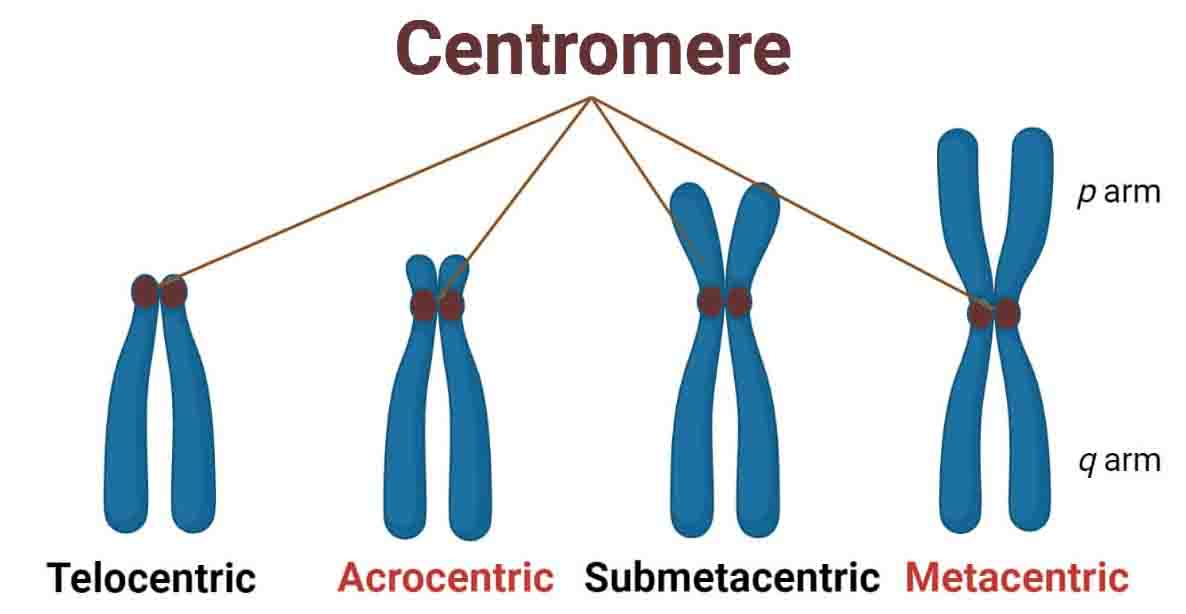Centromere Definition
The centromere is the point on a chromosome where mitotic spindle fibers attach to pull sister chromatids apart during cell division.
When a cell seeks to reproduce itself, it must first make a complete copy of each of its chromosomes, to ensure that their daughter cell receives a full complement of the parent cell’s DNA.
The two copies of each chromosome often remain stuck together until they are separated, with one copy going to each daughter cell. While stuck together, these two copies are called “sister chromatids.”
As a cell prepares to divide, the sister chromatids begin to become unstuck from each other until they are almost completely separated. They remain joined, however, at the centromere – a special region that plays a vital role in cell division.
At the centromere, elements of the cell’s cytoskeleton assemble and attach. First, a complex of proteins called the kinetochore assembles around the centromere region of DNA; then, mitotic spindle fibers attach to the kinetochore. The other end of these fibers are anchored to opposite ends of the parent cell, which will shortly split to become new daughter cells.
When the spindle fibers begin to contract, the chromatids are pulled to opposite ends of the parent cell. In this way, when the parent cells splits in two during cytokinesis, each sister chromatid becomes a chromosome of the new daughter cell.
To understand this process, it is important to remember that each sister chromatid is actually a full copy of the parent cell’s chromosome.
The two sister chromatids combined are often referred to as a single chromosome because they are packaged tightly together – but each contains all the information of the original chromosome, so when they split, each becomes a complete chromosome containing all of the information contained in the parent cell’s original chromosome.
The image below provides a visual illustration of the cell’s preparations to undergo cell division. Note that in phase 2 the nuclear envelope dissolves, leaving the chromosomes free in the cytoplasm.
In stages 3 and 4, the DNA condenses into tightly-packed chromosomes, in which sister chromatids are paired up and joined at their centromere. In stage 5 pictured below, the sister chromatids are pulled apart to opposite sides of the cell.
Function of Centromere
All living things are made up of cells. In order for cells to grow or reproduce, cell division must occur. In cell division, one “parent” cell splits in two, with each of the resulting cells being “daughter” cells.
For each daughter cell to survive, it is essential that they get a copy of each of their parent cells’ chromosomes.
When this does not happen, and daughter cells receive incomplete information, or too many copies of one chromosome, serious disease or cell death can result.
To ensure that a full copy of its DNA is given to each daughter cell, a cell first makes a complete copy of its DNA. The two copies stick together, ultimately condensing to form sister chromatids, until they are pulled apart during cell division.
The centromere of the chromosome provides a binding site for the mitotic spindle fiber that will attach to each sister chromatid and pull them to opposite ends of the parent cell, which will ultimately become the cytoplasm of the two daughter cells.
In cases where centromeres do not function properly, cells cannot successfully divide. Any attempt to do so results in daughter cells which do not have the genetic instructions they need to survive.
Centromere dysfunction leading to problems with chromosome sorting is believed to play a role in many instances of miscarriage, in which inherited centromere disorders may result in early embryonic death. Centromere dysfunction is also suspected to play a role in cancer cells, which display massive chromosome imbalance of the type that would be expected if the sorting of chromosomes during cell division failed.
Types of Centromeres
Point Centromeres
Point centromeres are centromeres where mitotic spindle fibers are attracted to specific sequences of DNA. In these cases, the cell has proteins that bind to these specific DNA sequences, and these proteins form the basis for the binding of the mitotic spindle fibers.
In these cases, mitotic spindle fibers will typically appear anywhere that the DNA sequence of the point centromere appears. The protein that begins the creation of the mitotic spindle fiber complex will bind to that DNA sequence without regard for its location or other factors.
Regional Centromeres
Humans and most eukaryotic cells use regional centromeres. These are centromeres where mitotic spindle binding is determined, not by a precise sequence of DNA, but by a combination of characteristics working together to signal the location of a centromere.
In regional centromeres, it is thought that epigenetic marks tell the proteins that begin to build the mitotic spindle complex where to bind.
“Epigenetic marks” are chemical changes made to DNA by enzymes, which can change the DNA’s chemical properties and other properties. Epigenetic marks can be added or removed without changing information contained in the DNA.
Related Biology Terms
- Epigenetic marks – Chemical changes which can be made to DNA by enzymes. Epigenetic marks are reversible and are thought to play a role in organizing chromosome formation and regulating gene expression.
- Kinetochore – A protein structure that forms around the centromeres during cell division. It is the kinetochore to which the mitotic spindle fibers attach.
- Mitosis – The most common type of cell division used by eukaryotic cells. Under specific circumstances, other methods of cell division, such as meiosis, might be used.

